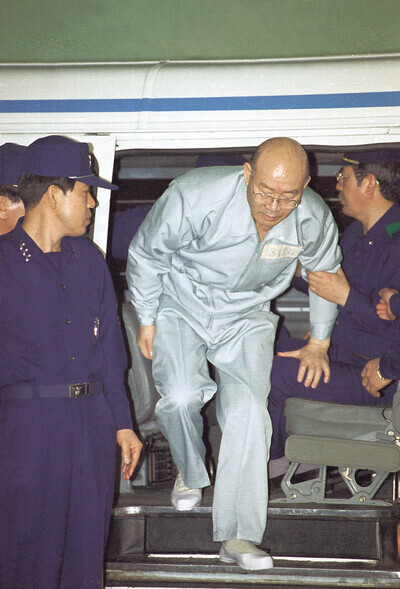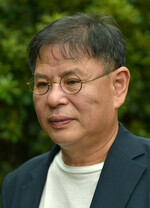hankyoreh
Links to other country sites 다른 나라 사이트 링크
[Column] Chun may be gone, but the struggle marches on


A heavy snow alert had been issued for the Honam region that morning as I boarded a city bus to Seoul’s Insadong neighborhood to see an exhibition titled “Meeting Yoon Sang-won through Writing, Ink-and-Wash Painting, and Photography.” The cold had descended suddenly, and people were scuttling down streets, their collars turned up.
Gazing out the bus window onto the early winter landscape, I found myself thinking of Ha Seong-heup — an artist who had often painted Yoon over the years — when I heard the news that Chun Doo-hwan had died.
My mind went blank for a moment, and then image after image flashed before my eyes like a film. I thought of the South Jeolla Provincial Office, how it looked out over Gwangju’s Geumnam Road with decades of grief inscribed in its windows.
And when I arrived at the Insadong gallery, I met Yoon himself.
“Today, we may be defeated. But tomorrow’s history will show us to be victors.”
Those words were spoken by Yoon as a spokesperson for the citizens’ army during the Gwangju Democratization Movement of May 1980. Early in the morning on the 27th of that month, he was killed while fighting at the South Jeolla Provincial Office.
Chun, in contrast, had won — turning the office into a scene of carnage and going on to become president of the Republic of Korea.
Forty-one years have passed since then. Yoon died in defeat at the South Jeolla Provincial Office. He was brought back through the “Marching for our Beloved” — becoming, as the Shin Dong-yeop House and Museum webpage puts it, “not a memory we cherish, but a presence that lives and defies.”
After his “victory” at the South Jeolla Provincial Office, Chun became the president. Taking the reins of the military dictatorship from Park Chung-hee, he inherited with the position all of his predecessor’s most engrained DNA: the techniques of hunting people down, torturing them, and imprisoning them.
In addition to the massacre in Gwangju, he would continue perpetrating covert acts of murder. Students forcibly conscripted into the military were killed under the guise of accidents; students and workers were tortured and slain. Chun did not shy away from having people killed as he enlisted plainclothes police to crack down on demonstrations.
In addition to the murders, the prisons were left overflowing with prisoners. Plainclothes police infiltrated college campuses — even classrooms — to conduct surveillance. Seemingly every house on every side street had someone who was wanted for arrest.
Parents of sons and daughters who took part in demonstrations were put under surveillance themselves; some were eventually driven out from their workplaces. Korea’s political division was used as a tool itself, as trumped-up espionage charges were used periodically as a means of thwarting the democratization movement.
Farmers and workers were forced out of their jobs, and blacklisting was used to seal off any avenues of employment.
Ironically, however, Chun Doo-hwan was himself a living milestone in the journey toward democracy. The more he tried to suppress the people fighting for democracy, the fiercer and more ardent their resistance became.
As tanks and regular army troops disappeared from campuses, students held their fists high. At factories, workers exchanged glances as they organized democratic unions. Farmers took to the streets to battle for their right to survive.
On their last day in the South Jeolla Provincial Office, members of the citizens’ army perished under a bloodstained banner rather than raise the white flag.
In the wake of Gwangju, the public did not lower their flags for even a single day. They fought and fought, until their efforts came to fruition in the June Struggle of 1987.
All of that was thanks to Chun Doo-hwan. They were able to persist in this intense battle precisely because someone like Chun held the presidency.
Having died in battle, Yoon Sang-won came back to fight against Chun in the form of Yoons in the thousands and hundreds of thousands — on Geumnam Street, in Jongno, at Gwanghwamun, on Seoul Plaza in front of City Hall.
Having carried on the mantle of the workers’ rights martyr Jeon Tae-il, Yoon himself returned to us in the form of Park Jong-chul and Lee Han-yeol. I feel truly grateful to Chun — for it is he who brought Yoon back from the dead.
Despite occupying the presidency, Chun Doo-hwan had to die over and over each day. He died in images, in songs, in poetry, and in films.
He was convicted by the court of history. He was forced to go into hiding at Baekdam Temple, and he spent a long time in prison. Even after his victory, Chun crashed to the ground.
As the man responsible for deepening these wounds, he had to spend 41 years as an entombed symbol of the past. For him, glory was short-lived, while humiliation was eternal.
Chun scorned the Gwangju struggle until his last moments. He refused to admit giving orders to open fire there and continued to insist that the North Korean military had been involved — a stance of blatant hypocrisy and excuse-mongering that he kept up even in the courtrooms of positive law. He went so far as to overtly deny that the massacre happened in his autobiography.
To the very end, he showed no hint of any sort of reflection. I have to wonder if there has been a more wretched loser in South Korean history than Chun Doo-hwan.
But as long as there are people who commemorate him and mourn his loss, everything remains ongoing: the May 1980 Democratization Movement, the June Struggle of 1987, and the candlelight struggle. It’s not over yet.
Please direct comments or questions to [english@hani.co.kr]

Editorial・opinion
![[Editorial] Yoon must halt procurement of SM-3 interceptor missiles [Editorial] Yoon must halt procurement of SM-3 interceptor missiles](https://flexible.img.hani.co.kr/flexible/normal/500/300/imgdb/child/2024/0501/17145495551605_1717145495195344.jpg) [Editorial] Yoon must halt procurement of SM-3 interceptor missiles
[Editorial] Yoon must halt procurement of SM-3 interceptor missiles![[Guest essay] Maybe Korea’s rapid population decline is an opportunity, not a crisis [Guest essay] Maybe Korea’s rapid population decline is an opportunity, not a crisis](https://flexible.img.hani.co.kr/flexible/normal/500/300/imgdb/original/2024/0430/9417144634983596.jpg) [Guest essay] Maybe Korea’s rapid population decline is an opportunity, not a crisis
[Guest essay] Maybe Korea’s rapid population decline is an opportunity, not a crisis- [Column] Can Yoon steer diplomacy with Russia, China back on track?
- [Column] Season 2 of special prosecutor probe may be coming to Korea soon
- [Column] Park Geun-hye déjà vu in Yoon Suk-yeol
- [Editorial] New weight of N. Korea’s nuclear threats makes dialogue all the more urgent
- [Guest essay] The real reason Korea’s new right wants to dub Rhee a founding father
- [Column] ‘Choson’: Is it time we start referring to N. Korea in its own terms?
- [Editorial] Japan’s rewriting of history with Korea has gone too far
- [Column] The president’s questionable capacity for dialogue
Most viewed articles
- 1Months and months of overdue wages are pushing migrant workers in Korea into debt
- 2Trump asks why US would defend Korea, hints at hiking Seoul’s defense cost burden
- 3[Editorial] Yoon must halt procurement of SM-3 interceptor missiles
- 4At heart of West’s handwringing over Chinese ‘overcapacity,’ a battle to lead key future industries
- 5[Guest essay] Maybe Korea’s rapid population decline is an opportunity, not a crisis
- 6Fruitless Yoon-Lee summit inflames partisan tensions in Korea
- 7First meeting between Yoon, Lee in 2 years ends without compromise or agreement
- 8Dermatology, plastic surgery drove record medical tourism to Korea in 2023
- 9Under conservative chief, Korea’s TRC brands teenage wartime massacre victims as traitors
- 10Anti-immigration candidate marauds across Korea with squad detaining foreigners